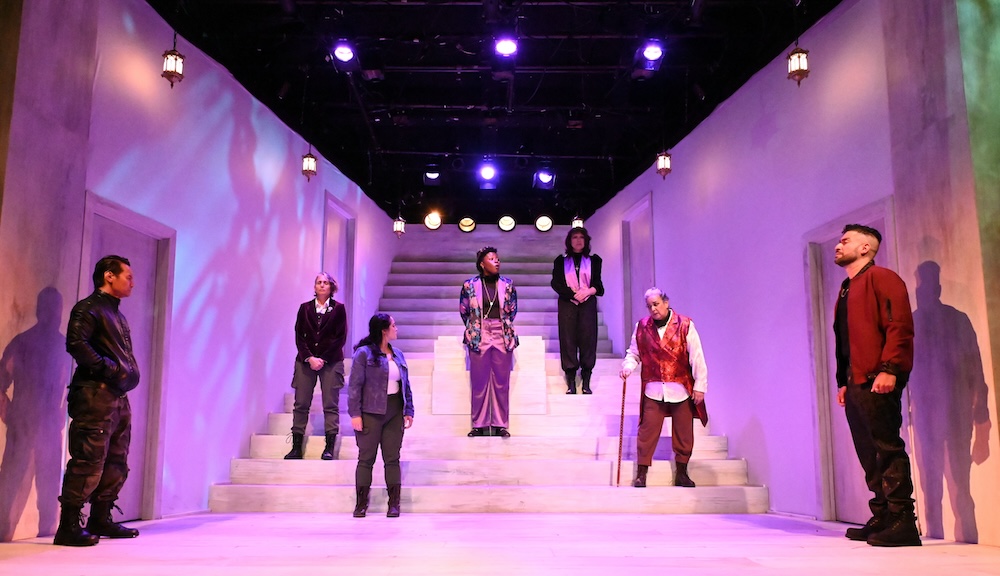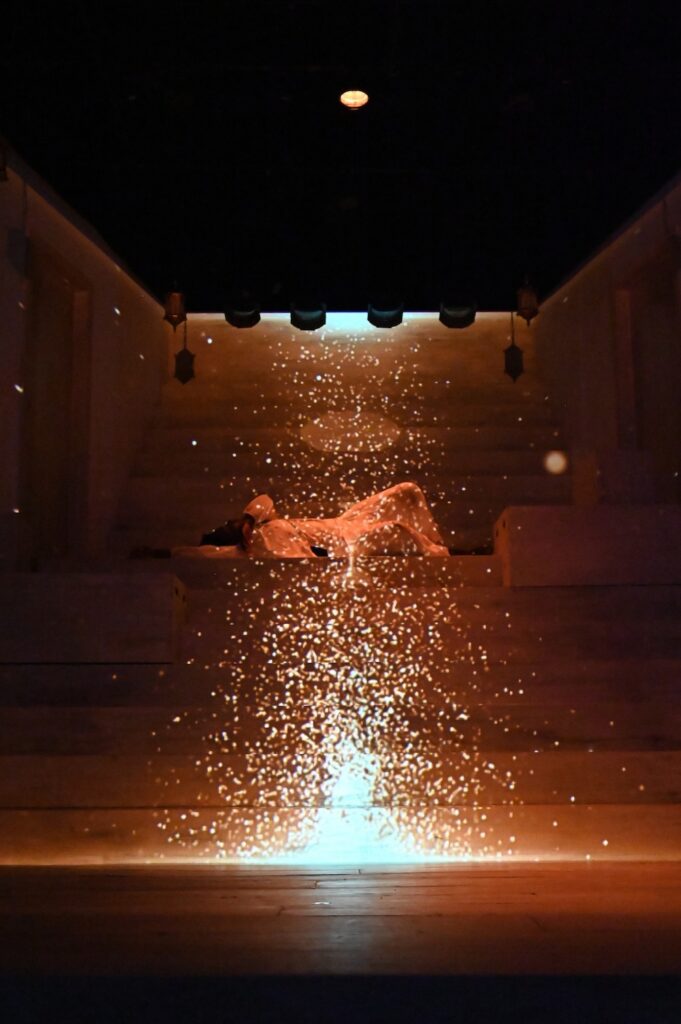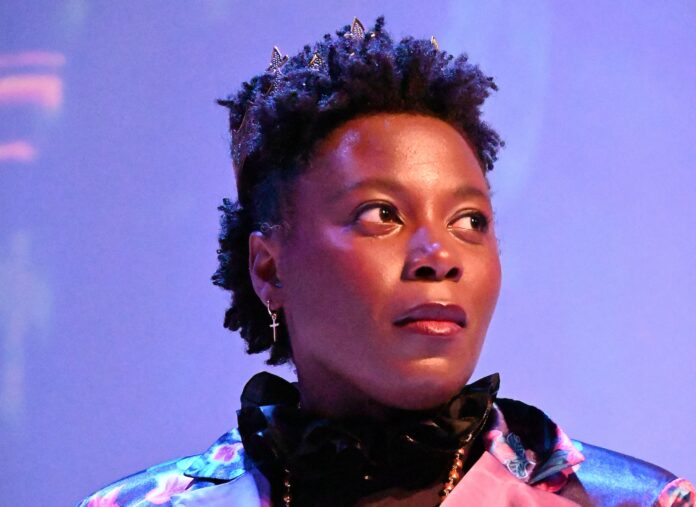If there is one indisputable superstar of Play On Shakespeare’s new production of Richard II (through September 8 at Magic Theatre in Fort Mason, SF), it’s scenic designer Tanya Orellana. Over the past few years, she’s been making a name for herself with a series of eye-catching designs for ACT, SF Playhouse, Cal Shakes, Magic Theatre, and more. Her work fluctuates from the cleanly streamlined to the intricately detailed, much of it flush with the presence of seamlessly integrated video projections.
Her design for Richard II is as simple as it gets: stairs. That’s it. There are some lamps that hang from above, some hidden doors on the far ends of the stage, and the centerpiece, a series of blocks that form a throne for the eponymous English king (played the ever-talented Jeunée Simon). But they’re still just a set of stairs in white paint (which appears to be fading) ascending from far-downstage to far-upstage. The steps recall the infamous sets from Shotgun Players’ productions of Passing Strange and Midsummer, but aren’t nearly as constricting to the cast’s movements. Orellana’s set is dynamic in its simplicity.

I bring this up at the start because there are a lot of elements and people in this production that make for good theater. Unfortunately, they don’t quite gel together. The first of Shakespeare’s “Henriad” tetralogy is here adapted by Naomi Iizuka, who wrote the Magic’s recent sci-fi/cli-fi drama piece, Garuda’s Wing. A number of that show’s collaborators (including Orellana) return for this production, suggesting they had so much fun the first time that they wanted to do it again. That’s all fine and well, but their enthusiasm doesn’t necessarily translate onstage.
For those unfamiliar: this Shakespearean historical tragedy (which Iizuka has truncated from five acts to one piece that runs nearly two hours) begins with the titular king sitting in judgment for a trial-by-combat between his cousin, Henry Bolingbroke (Juan Amador), and the irate Thomas Mowbray (Ogie Zulueta). We see them fight, but Richard calls it early and simply has both guys banished, much to the horror of John Gaunt (Catherine Castellanos), Richard’s uncle and Henry’s father. Gaunt sees off his son with as much composure as he can muster, but it isn’t long before the younger Gaunt swears revenge (as Shakespeare characters are wont to do.)
When the elder Gaunt dies and Richard seizes all his assets, the nobles (most of the cast, primarily the dynamic duo of Nora El Samahy and Mia Tagano) are none too happy about it. Richard finds himself surrounded by people who want him dead, and evermore distant from his unnamed queen (the always-great Kina Kantor), whose most recent encounter with Richard may be their very last.
All of this has the makings of great theater. Yet, director Karina Gutiérrez never quite makes the pieces fit. Pulling off a Shakespearean epic with cast of seven isn’t impossible (Cutting Ball famously did The Tempest with a cast of only three), but the illusion can’t be broken when an actor leaves the stage to return as a different character. Despite the aforementioned stage doors providing ample opportunity for this sort of entrances and exits, Gutiérrez instead has the cast clumsily switch in and out of Kyo Yohena’s colorful costumes onstage. This leads to awkward moments, as when Castellanos—a genuine theatrical presence if there ever was one—dies onstage as Gaunt, turns around, throws on a few items, then announces Gaunt’s death. It all takes place in full view of the audience. Such transitions take place over the course of nearly two hours.
It isn’t as if Gutiérrez had amateurs to work with. The majority of the cast are some of the Bay Area’s best actors (Amador has become a Magic regular, and one hopes that won’t change anytime soon), but they can only do so much when working with awkward blocking that suggests a director still learning their craft. There are moments that don’t land, even with Iizuka’s streamlined script.

Speaking of which: said script mostly succeeds in excising any bloat from the Bard’s story, but it probably could have used a bit more pruning. I’m not sure if this was due to the direction or the adaptation, but, as mentioned above, the promoted-as-90-minute-show ran for nearly two hours on opening night. Iizuka wasn’t trying anything as wide-ranging as Cal Shakes’ miscast 2018 “War of the Roses” production, but she could have leaned even further towards Tom Stoppard’s 15-Minute Hamlet, dropping several more characters and soliloquies for the sake of pacing (and to get better use out of the seven-person ensemble.) As it stands, the show often has a bit too much air between words.
I don’t know Magic’s regular masking policy, but I was glad to see that opening night was a mask-required performance (though not everyone followed that mandate.) Instead of their usual space (which is currently running the great Shipping & Handling by Crowded Fire), this production takes place in the updated theater across the way. This one has a noticeably-more-modern HVAC system, which maintained a cool temperature throughout the entire show. Not only that, but there were HathaSpace HSP002 air purifiers placed around the theater. In fact, I was seated next to one. With all of these factors working in the company’s favor, not even a nearly full house could push my Aranet4’s CO² readings any higher than the mid-800s. By the final bow, it was reading only 829ppm, which isn’t bad at all.
There’s so much working to the benefit of this Richard II production that it’s a shame it doesn’t seem to come together. The pared-down recipe makes sense, and the head chef has a top-notch army of line cooks at her disposal, but the final dish doesn’t quite add up to the sum of its ingredients. It’s a very pretty production of one of Shakespeare’s less-performed epics, but it never quite becomes more than that.
RICHARD II runs through September 8. Magic Theatre, SF. Tickets and more info here.




